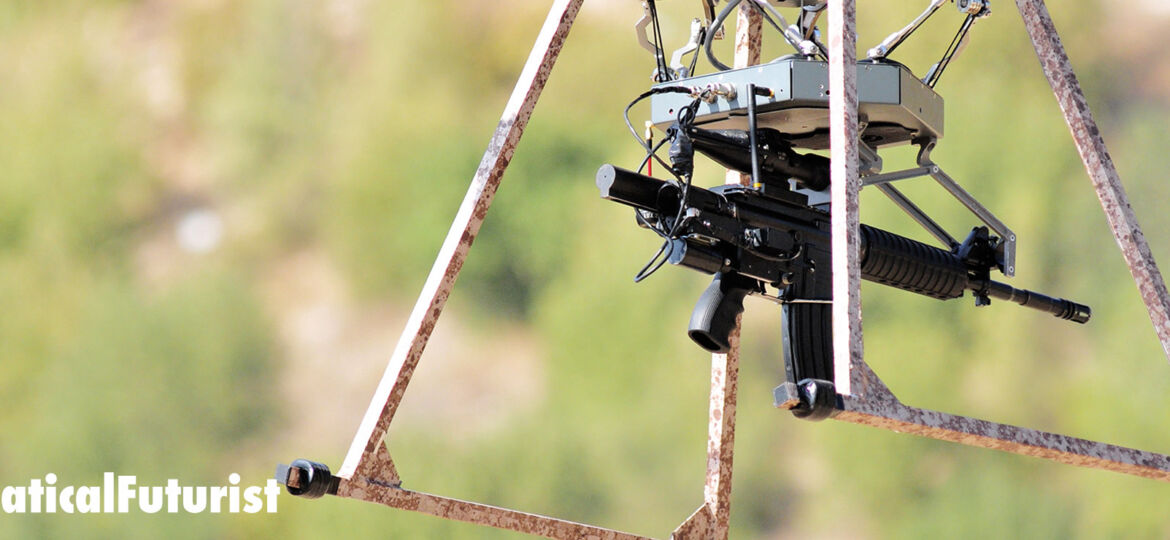
WHY THIS MATTERS IN BRIEF
The race to automate war, and arm drone platforms, is accelerating almost unchecked and whether or not it’s a good thing depends on your point of view.
America has some 300 million guns in circulation, and, we all know how much some most people like lazing around on the sofa, hey who doesn’t, but up until now trying to combine the two hobbies has been difficult. But the wait is over, because yes, we now finally have a company that’s manufacturing gun toting drones that you can control from your sofa, or from your army’s forward operating base, anyway, which in some theatre’s of war simply translates into a sofa in the desert.
In 2015 a video that showed a semi-automatic handgun being fired from a custom-built drone went viral, raising concerns for authorities, including the FAA, who while they’re softening their stance on drones and letting companies like 7 Eleven, Amazon and UPS conduct drone deliveries it’s fair to say would have kittens if these new suckers started showing up for real. And armed drones are a problem that some authorities at least are taking more seriously, which is why we’re now starting to see a rise in the number of FAA approved drone defence systems, as well as an increase in the number of drone air traffic control programs.
As drones and “robotic” weapons platforms are increasingly adopted and developed by almost every arm of the US Military, as well as others, whether it’s the US Marines going all in on hunter-killer drones, the US Airforce deploying and controlling drone swarms from F-35’s and F/A-18’s, building F-16 drones, or even turning the F-35 itself into the world’s largest autonomous drone, or the US Navy standing up the first autonomous drone squadron out of Jacksonville, Florida, and launching the world’s first autonomous mine hunters, semi-autonomous destroyers and subs, one thing was always certain – one day, these smaller drones were going to get weaponised.
This week Florida based startup Duke Robotics unveiled the TIKAD, a custom built quadcopter that can carry and fire various military weapons, including semi-automatic rifles and grenade launchers.
Duke Robotics is co-founded by Raziel Atuar, a former Special Mission Unit commander in the Israel Defense Force who was inspired to develop this drone system after experiencing the difficulty of battling terrorist agents that operate within civilian populations. As we have seen in recent years, shooting missiles into populated areas frequently results in horrific collateral damage.
“The primary solution you’re left with is sending in ground troops – but this shifts the risk to your troops, which often leads to injuries and casualties,” says Atuar, “but, we thought, ‘what if there was a better way’.”
TIKAD has been in development for several years and an early prototype, based on a consumer drone, was successfully deployed by the Israeli military to take out targets in 2015, and since then, the device has been refined and a proprietary stabilisation system has been developed to absorb any recoil from the firing of a weapon.
In a recent interview Atuar said the current device can carry and fire a variety of different weapons up to a weight of 22 lb (10 kg), and the accompanying promotional video, above, shows how the drone is remotely operated. That said though, a human still needs to be on the other end to control the drone and weapon, at least for now.
The idea of reducing both civilian and military casualties using weaponised drones is, on one hand, an appealing prospect to almost every military on Earth, but it’s also undeniable that the idea of fleets of drones with machine guns is absolutely horrifying, especially when we realise that at some point one military complex, somewhere, will decide that fully autonomous drones are a great idea – at which point warfare will have changed forever.
However, as for the future of humanity and the debate about reigning in the use of “killer robots and autonomous weapons platforms,” well, thank heavens we can depend on the UN who earlier this year, just like they have every year since 2013, committed to debate the issue and create a draft set of resolutions, this August.
Well, that was the plan, but what happened in reality was the UN ended up cancelling this year’s debate, just like it’s cancelled the debate for the past five years, because Brazil owed them money, and I think you’ll agree it’s great to see the world’s officials taking the issue so seriously.
Meanwhile, the race to automate war rages on… maybe we should start a kickstarter to fund the UN’s meeting room and donut bar?
















